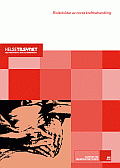Risk profile of treatment of cancer in Norway
Summary of Report of the Norwegian Board of Health Supervision 4/2010

One of the aims of the Norwegian Board of Health Supervision is to improve our supervision of specialized health services. As part of this aim, we decided to carry out risk analyses related to specific diagnostic groups or medical specialties at the countrywide level. This is the first time we have carried out this type of risk analysis, and treatment of cancer was chosen as a pilot project.
The main aim of this simplified risk analysis of treatment of cancer was to identify at least 15 of the most important types of adverse events or conditions in the treatment of cancer, and to rank them in a risk matrix.
In preparation, we produced a document in which we identified 50 possible types of adverse events/conditions. We arranged a seminar, where we discussed the data and the risk profile. Twentythree people participated in the seminar: 21 professionals from health trusts and municipal health services, representing a wide range of professional skills, and 2 participants from regional health authorities. Using a stepwise process, the working group identified the 16 most important types of adverse events/ conditions related to treatment of cancer. These were summarized in a risk matrix, according to consensus within the group.
This risk analysis, seen in relation to information the Norwegian Board of Health Supervision already had, shows that the level of risk associated with the treatment of cancer is too high. Health services should use the results of this analysis to give priority to measures to eliminate or reduce possible causes of risk. The most important risk areas that were identified were: investigation logistics (late diagnosis), flow of information, lack of continuity in patient care, and monitoring of complications. We need to develop new indicators of risk in the treatment of cancer in order to quantify the risks better, and in order to improve risk surveillance in many areas.
We have assessed the results in the light of the results of relevant Dutch and Danish studies.
The Norwegian Board of Health Supervision wishes to thank those who participated in the seminar and those who provided us with data, for their valuable contribution to this risk analysis of treatment of cancer in Norway.